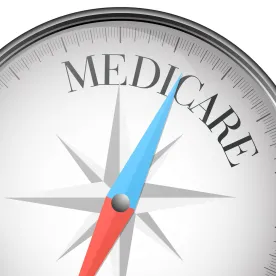Editor’s Note: This article is the third of a four-part series discussing specific telemedicine and digital health features in the 2022 Medicare Physician Fee Schedule proposed rule. Read part 1 of this series here and read part 2 here.
On July 13, 2021, the Centers for Medicare and Medicaid Services (CMS) released an advance copy of the calendar year (CY) 2022 Medicare Physician Fee Schedule (PFS) proposed payment rule, to be published on July 23, 2021. While the proposed rule introduces some new virtual care services (including Remote Therapeutic Monitoring), CMS rejected all requests to permanently add new telehealth services next year.
This article discusses: 1) the current state of Medicare telehealth services; 2) requests for new telehealth services; 3) extending the timeframe for Category 3 temporary codes; 4) a new permanent code for virtual check-ins longer than 10 minutes; and 5) whether CMS should continue allowing direct supervision via telemedicine.
Medicare Telehealth Services Post-COVID
Telemedicine and digital health technology is becoming an established part of medical practice and is very likely to persist after the COVID-19 pandemic. According to CMS data, before the Public Health Emergency (PHE), 15,000 Medicare patients each week received a telemedicine service. By April 2020, that number grew to nearly 1.7 million Medicare patients each week. Nearly half of all Medicare primary care visits in April 2020 were telehealth encounters, a level consistent with health care encounters more broadly. Between mid-March and mid-October 2020, over 24.5 million patients (approximately 40% of all Medicare patients) had received a telemedicine service. The data reveals how providers have begun to successfully integrate telemedicine into traditional health care delivery approaches.
The current list of Medicare-covered telehealth services includes approximately 270 services, with 160 services added on a temporary basis (including service categories such as emergency department visits, initial inpatient and nursing facility visits, and discharge day management services) and covered through the end of the PHE.
No New Telehealth Services Proposed For 2022
CMS received several requests to permanently add various services to the Medicare telehealth services list effective for CY 2022. Unfortunately, none of the requests met CMS’ criteria for permanent addition to the Medicare telehealth services list. The requested services are listed in the table below.
| SERVICE | CPT CODE |
| Urodynamics | CPT code 51741 |
| Biofeedback | CPT codes 90901, 90912, and 90913 |
| Neurological & Psychological Testing Services | CPT codes 96130 – 96133 and 96136 – 96139 |
| Therapy Procedures | CPT codes 97110, 97112, 97116, 97150, and 97530 |
| Physical Therapy Evaluations | CPT codes 97161 – 97164 |
| Therapy Personal Care services | CPT codes 97535, 97537, and 97542 |
| Therapy Tests and Measurements services | CPT codes 97750, 97755, and 97763 |
| Personal Care | CPT codes 98960 – 98962 |
| Evaluative and Therapeutic Services | CPT codes 92607 – 92609 |
CMS found that the codes did not meet the criteria for addition to the Medicare telehealth services list on a Category 1 or Category 2 basis, citing concerns over patient safety, the ability of the services to be accurately and thoroughly performed via telehealth, and insufficient information to demonstrate a clinical benefit to Medicare beneficiaries.
Extended Timeframe for Category 3 Temporary Codes
Last year, CMS created a set of “Category 3” codes to designate telehealth services covered temporarily during the PHE, but for which CMS has not yet developed evidence sufficient to meet the requirements for permanent coverage. Practitioners have been asked to collect clinical data to help CMS determine whether these codes should be added on a permanent basis.
Currently, coverage of Category 3 codes lasts through the end of the calendar year in which the PHE ends, but CMS has proposed extending that expiration date to December 31, 2023. This move is intended to allow more time to compile data on Category 3 codes, utilization levels of these services during the PHE, and give stakeholders more opportunity to develop support for the permanent addition of these services to the Medicare telehealth services list.
Category 3 codes are a subset of codes added to the Medicare telehealth services list on a temporary basis during the PHE. However, not all temporary telehealth codes are within Category 3. Coverage of these other interim codes will end alongside the PHE expiration date. To that end, CMS is seeking comments on whether or not these other interim codes (i.e., those temporarily-added as telehealth services during the PHE but not Category 3) should be added to the Medicare telehealth list on a Category 3 basis.
New Virtual Check-In Code Made Permanent
Communication Technology-Based Services (CTBS) are brief communication services conducted over different types of technology to avoid unnecessary in-person office visits. These services, by definition, are virtual and do not replace services that would normally be performed in-person. CMS created HCPCS code G2252 to cover extended services delivered via synchronous communication technology, including audio-only (e.g., virtual check-ins). HCPCS code G2252 has been covered on a temporary basis only, but CMS proposed to permanently adopt it for CY 2022. The service is described in the CY 2021 PFS final rule as follows:
G2252 (Brief communication technology-based service, e.g. virtual check-in, by a physician or other qualified health care professional who can report evaluation and management services, provided to an established patient, not originating from a related E/M service provided within the previous 7 days nor leading to an E/M service or procedure within the next 24 hours or soonest available appointment; 11-20 minutes of medical discussion.)
The code is intended for situations when the acuity of a patient’s problem is not necessarily likely to warrant an in-person visit, but when more than 5-10 minutes is needed to make that assessment. Because it is a CTBS, the traditional telehealth service restrictions do not apply, so G2252 can be used even if the patient is not at a qualified originating site. The technology must be synchronous and is subject to the same billing requirements as the other virtual check-in codes.
Should CMS Continue To Allow Direct Supervision via Telehealth?
CMS seeks comments on whether to adopt a policy to permanently allow provision of direct supervision via telehealth. For Medicare purposes, direct supervision requires the physician to be physically present in the same office suite as the supervised non-physician, and immediately available to furnish assistance and direction throughout the performance of the procedure.
In the 2021 Medicare Physician Fee Schedule, CMS temporarily changed direct supervision rules to allow the supervising physician to be remote and use real-time, interactive audio-video technology. This change does not require the physician’s real-time presence at, or live observation of, the service via interactive audio-video technology throughout the performance of the procedure.
The supervision change is temporary because CMS was concerned widespread direct supervision through virtual presence may not be safe for some clinical situations (e.g., is virtual direct supervision appropriate in complex, high-risk, surgical, interventional, or endoscopic procedures, or for patients with dementia, or patients where an in-person physical examination is necessary and important?). The direct supervision waiver will expire December 31, 2021 or the end of the PHE (whichever is later).
CMS is considering whether or not it should make permanent the ability to fulfill direct supervision via interactive audio-video technology. To that end, CMS has requested stakeholder comments on the following:
-
Have practitioners conducted direct supervision via telemedicine? How frequently have they used it? How likely are practitioners to use telemedicine for direct supervision after the PHE ends?
-
Should direct supervision via telemedicine be made permanent? If not, should CMS facilitate a gradual sunset of the policy?
-
Should CMS extend the deadline for direct supervision via telemedicine, in order for stakeholders to gather additional information and allow CMS to better assess the implications of a permanent change in this policy?
-
Should CMS make permanent direct supervision via telemedicine for only a defined subset of services? Namely, should CMS allow it only for those services where the lack of in-person presence does not raise patient safety concerns?
-
If this policy were to be made permanent, should CMS require a service level modifier to identify when telemedicine was used to fulfill direct supervision?
How to Submit Comments on the Proposed Rule
Providers, technology companies, and virtual care entrepreneurs interested in telemedicine should consider providing comments to the proposed rule. CMS is soliciting comments until 5:00 p.m. on September 13, 2021. Anyone may submit comments – anonymously or otherwise – via electronic submission at this link. When commenting, refer to file code CMS-1751-P in your submission. Alternatively, commenters may submit comments by mail to:
-
Regular Mail: Centers for Medicare & Medicaid Services, Department of Health and Human Services, Attention: CMS-1751-P, P.O. Box 8016, Baltimore, MD 21244-8016.
-
Express Overnight Mail: Centers for Medicare & Medicaid Services, Department of Health and Human Services, Attention: CMS-1751-P, Mail Stop C4-26-05, 7500 Security Boulevard, Baltimore, MD 21244-1850
If submitting via mail, please be sure to allow adequate mailing time before the date comments are due to CMS.






 />i
/>i

